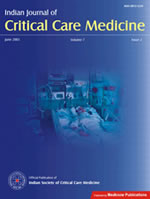
|
Indian Journal of Critical Care Medicine
Medknow Publications on behalf of the Indian Society of Critical Care Medicine
ISSN: 0972-5229
EISSN: 0972-5229
Vol. 14, No. 2, 2010, pp. 77-82
|
 Bioline Code: cm10013
Bioline Code: cm10013
Full paper language: English
Document type: Research Article
Document available free of charge
|
|
|
Indian Journal of Critical Care Medicine, Vol. 14, No. 2, 2010, pp. 77-82
| en |
Critically ill patients with 2009 H1N1 infection in an Indian ICU
Chacko, J.; Gagan, B.; Ashok, E.; Radha, M. & Hemanth, H. V.
Abstract
Background and Aims: The 2009 pandemic influenza A (H1N1) has taken its toll across most parts of India. We aimed to study its epidemiology, clinical characteristics and outcomes from an Indian multidisciplinary intensive care unit (ICU).
Materials and Methods: All patients admitted to our ICU with a flu-like illness and who tested positive for the 2009 H1N1 by reverse -transcriptase polymerase- chain -reaction assay during a 3 month period were prospectively studied.
Results: Thirty one patients were admitted to the ICU during the study period. Patients were in the younger age group with a median age of 35 years (IQR: 28.2-42.8). Obesity was the commonest risk factor. Twenty six patients (83.9%) required ventilator support; the median duration of ventilator support was 10 days (IQR: 4-22). Severe hypoxemia was the predominant feature in all patients. Circulatory failure requiring vasopressors occurred in 18 (58.1%) patients and acute kidney injury in 6 (3.2%) patients. Twenty six patients were alive at the end of 28 days; subsequently all except one were discharged. The median duration of hospital stay was 15 (IQR: 8-22.5) days. Increasing APACHE II scores were associated with an increased risk of death (Hazard Ratio: 1.1; CI: 1.08 -1.2; P = 0.04). Mean tidal volumes in non-survivors were significantly lower; this was related to poor lung compliance in this group.
Conclusions: 2009 H1N1 infection caused severe disease in relatively young patients without significant co-morbidities, characterized by severe hypoxemia and the requirement for prolonged mechanical ventilation. Extra-pulmonary organ failure included circulatory and renal failure.
Keywords
H1N1, influenza, virus, intensive care
|
| |
© Copyright 2010 Indian Journal of Critical Care Medicine.
Alternative site location: http://www.ijccm.org/
|
|
